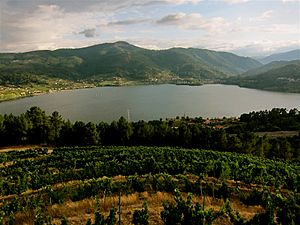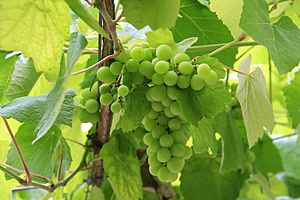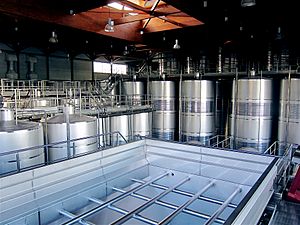Galician wine facts for kids
Galician wine comes from Galicia, a region in the northwest part of Spain. This area is known for making many different kinds of wine. Galicia has four main areas where wine is made: A Coruña, Ourense, Pontevedra, and Lugo.
Within Galicia, there are five special wine regions called Denominacións de Orixe (DO). These are Monterrei, Rías Baixas, Ribeira Sacra, Ribeiro, and Valdeorras. Recently, the wine industry in Galicia has become very popular. This is especially true for the Rías Baixas region, which is famous for its Albariño wines.
Contents
Climate and Geography of Galician Wine Regions
Galicia is right next to the Atlantic coast. This means it has a very wet climate. It gets over 1,300 millimeters (50 inches) of rain each year. Even with lots of rain, the region also gets more than 2,000 hours of sunshine. This sunshine helps make the area quite humid.
The Serra dos Ancares mountains are on the eastern border of Galicia, next to Castile and León. The Miño river forms part of the border with Portugal to the south. Because Galicia is so close to Portugal and a bit separate from the rest of Spain, its wines are often more like Portuguese wines.
The soil in the vineyards is different depending on the area. In Rías Baixas and most of Galicia, the soil is made of granite. In the Valdeorras region, the soil is mostly slate.
History of Galician Wine
People in Galicia have been making wine for a very long time. In the 1300s, Galicia was already sending plant cuttings to other vineyards in Europe. This shows how important wine was to the region.
In the 1800s, Galicia faced tough times. Many people moved away to find work, and many vineyards closed down. Galician workers even helped build the special terraced vineyards in the Douro region of Portugal, where Port wine is made.
Things started to get better when Spain joined the European Union in 1986. The EU provided money to help Galicia's wine industry grow again. This funding helped vineyards and wineries modernize and improve.
Growing Grapes and Making Wines in Galicia
Galicia is very good at growing grapes. It often produces some of the highest amounts of grapes in Europe. On average, vineyards here produce about 5.7 tons of grapes per acre. Most of the vineyards are in the southern parts of the region, in Ourense and Pontevedra. There are also some important vineyards in Lugo to the east.
Near the Miño river, white wines are often a mix of Albariño, Loureira, and Caiño blanca grapes. Further inland, white wines often blend Torrontés and Treixadura. Some white wines are mostly made from the Godello grape. The light red wines from Galicia are mainly made from the Mencía grape.
About 137 hectares (339 acres) of a grape called Camaraou noir (known as Espadeiro in Galicia) are grown here. It is often mixed with Mencía and Caiño tinto grapes.
Galician Wine Regions
Monterrei
The Monterrei DO is in the southern part of Galicia, right on the border with Portugal. This region first got its special DO status in the early 1980s. However, they lost it because Spanish officials felt the wine producers were not working hard enough to improve their wines. This made the producers in Monterrei work even harder. They modernized their vineyards and wineries, and the region got its full DO status back in 1994.
The main grapes grown in Monterrei are Alicante, Doña blanca, Godello, Gran negro, Mencía, Mouratón, and Palomino. Right now, this region mostly produces wine in large quantities.
Rías Baixas
The Rías Baixas is the most famous wine region in Galicia. It makes some of Spain's most popular dry white wines, mostly from the Albariño grape. People have made wine here for a long time. Exports to other parts of Europe started in the 1500s.
Later, a disease called phylloxera badly damaged the vineyards. Many vineyards were replanted with lower quality grapes. But in the 1970s, growers started planting native grapes like Albariño again. There are 12 types of grapes allowed in this region, including red grapes like Mencía. However, Albariño makes up 90% of all the wine produced here.
The soil in Rías Baixas is made of granite. This is perfect for the damp, maritime climate near the ocean. Even though other parts of Galicia produce a lot of grapes, Rías Baixas keeps its Albariño grape yields low. This helps make the wine very flavorful and aromatic. These wines usually have at least 12% alcohol and are almost always dry.
Other grapes grown in Rías Baixas include Brancellao, Caiño tinto, Caiño blanca, Loureira, Loureira Tinta, Sousón, Torrontés, and Treixadura. Rías Baixas is the Galician DO that sends the most wine bottles to other countries.
Ribeira Sacra
The Ribeira Sacra region got its DO status in 1996. For many years, most of the wine here was made from the Mencía grape. Some white wine was also made from Godello and Albariño grapes.
By the late 2000s, Palomino became the most planted grape. But Mencía is still very important, making "promising reds," according to wine expert Tom Stevenson. Stevenson also thinks that Albariño grown on the steep, terraced vineyards of Ribeira Sacra could make amazing wine.
Other grapes grown in the Ribeira Sacra DO include Brancellao, Caiño tinto, Caiño blanca, Doña blanca, Espadeiro, Ferrón, Garnacha, Loureira, Loureira Tinta, Merenzao, Negrada, Sousón, and Torrontés.
Ribeiro
The Ribeiro DO means "river banks" in Galician. It is located along the Miño river and its smaller rivers. It received its DO status in 1957. In the 1500s and 1600s, Ribeiro wine was often sent to England and Italy.
Like Rías Baixas, Ribeiro also suffered from the phylloxera disease. However, growers here quickly stopped planting low-quality grapes. They went back to native types like Torrontés, Treixadura, and Lado. These grapes make fresh, aromatic white wines. The red wines in this area are mostly made from the Garnacha Tintorera grape. These wines are dark in color but light in taste.
Because the climate is similar and influenced by the Atlantic, many Ribeiro wines taste like Portuguese wines from the nearby Vinho Verde region. However, Tom Stevenson notes that Ribeiro wines are often fruitier and more aromatic.
Other grapes grown in the Ribeiro region include Albariño, Brancellao, Caiño tinto, Caiño blanca, Ferrón, Garnacha, Godello, Jerez, Loureira, Mencía, Sousón, Tempranillo, Torronté, Treixadura, and Viura.
Valdeorras
The Valdeorras DO is the easternmost wine region in Galicia. It is known for the red Garnacha Tintorera grape and the white Palomino grape. Many vineyards are planted on terraces on the steep slate hillsides next to the Sil river.
Before the phylloxera disease in the 1800s, the native Godello grape was widely planted. It is only recently starting to become popular again in the region. The Mencía grape is also gaining popularity. It produces red wines that are fruity and easy to drink.
Other grapes grown in the Valdeorras region include Doña blanca, Godello, Gran negro, Lado, María Ardoña, Mencía, Merenzao, and Palomino.
See also
 In Spanish: Vino de Galicia para niños
In Spanish: Vino de Galicia para niños





